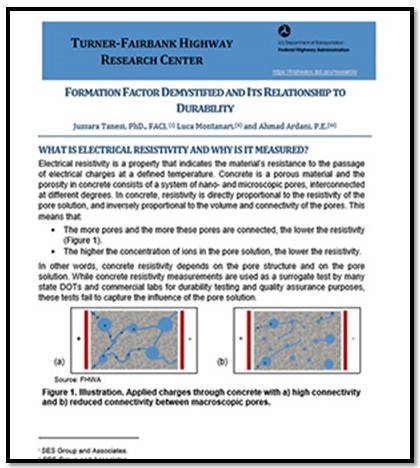U.S. Department of Transportation
Federal Highway Administration
1200 New Jersey Avenue, SE
Washington, DC 20590
202-366-4000
Federal Highway Administration Research and Technology
Coordinating, Developing, and Delivering Highway Transportation Innovations
| Fact Sheet |
| This techbrief is an archived publication and may contain dated technical, contact, and link information |
| Publication Number: FHWA-HRT-19-030 Date: April 2019 |
Publication Number: FHWA-HRT-19-030 Date: April 2019 |
PDF Version (1 MB)
PDF files can be viewed with the Acrobat® Reader®
| FHWA Publication No.: FHWA-HRT-19-030 Jussara Tanesi, PhD., FACI, (i) Luca Montanari,(ii) and Ahmad Ardani, P.E.(iii) |
Electrical resistivity is a property that indicates the material’s resistance to the passage of electrical charges at a defined temperature. Concrete is a porous material and the porosity in concrete consists of a system of nano- and microscopic pores, interconnected at different degrees. In concrete, resistivity is directly proportional to the resistivity of the pore solution, and inversely proportional to the volume and connectivity of the pores.

i SES Group and Associates.
ii SES Group and Associates.
iii FHWA contact: Ahmad.Ardani@dot.gov, 202–493–3422.